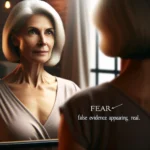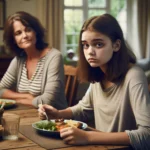To The Bone – What are you really looking for?
To The Bone – What are you really looking for?

My guess is that whatever you are looking for in the Netflix movie about eating disorders, To The Bone, you will find. If you are looking for eating disorder triggers in this story about a young woman who has anorexia nervosa, you will find them; if you are looking for hope, you will find this, too.
I believe that any story based on truth that brings eating disorders into the light is a plus. At the very least, it offers the opportunity for you and me to question and examine our beliefs and to consider new perspectives in understanding and addressing the mysteries and challenges of eating disorders.
Many factors determine what we each get out of an eating disorder story. If we have an eating disorder right now, our illness voice will dominate, pouncing on every triggering word it can find – twisting, turning and shouting commands in our brain. If we have started our recovery journey, our authentic voice will gather up the same words in the same story, and interpret them as helpful guidance and inspirational messages of hope. For instance specific weights, or calories consumed, may be triggering (I’m not “good” enough yet) when the illness voice is raging, but in recovery may serve as stark reminders of suffering and struggle (I’m determined to never go there again). Timing is everything.
Baring the truth to the public
The story in our private diary or journal can be ‘open slather’ on anything, for this is for our eyes only, but in a story shared publicly, our audience deserves consideration. Consensus is lacking on how much detail should be shared openly in real stories about eating disorders. To The Bone is filling a need in generating such discussion. An authentic story may not be pretty or romantic, but it can be gripping, educational – and hopeful.
The extent of triggering depends on factors including the viewer’s stage in recovery, the level of comparisons made between self and others, and identification with experiences related in the story. However, as noted above, the argument also may be made that frank depiction of “how bad things can get” can serve as a compelling reminder of the importance and urgency of accessing help and acquiring healthy coping skills. Triggers, let’s face it, are part of everyday life.
The truth is that an authentic account of someone incarcerated in an eating disorder has potential to create a horror story beyond belief to all but those who are experiencing or have experienced the illness. This is why, in reading a story or watching a movie that reveals the patient’s experience of an eating disorder, practicing self-care at all times is vital. Otherwise, vulnerable viewers are at risk of being drawn into, and becoming captive of, the charismatic, manipulative and ultimately soul-destroying and bullying voice of the illness. Remember, the eating disorder likes to dominate and isolate – to guard against this, I suggest you do not watch To The Bone alone.
Diversity in developing the narrative
Despite the potential triggers, distilling and developing the raw narrative of living with an eating disorder can help to reveal the complexities that lie within, and help to dispel public misconceptions and misunderstandings. For instance, through sharing our stories, we can reveal how eating disorders don’t discriminate on class, body size or other characteristics. A more diverse set of stories can also provide a space for people of varying ethnicities, genders, races, cultures and health challenges to discover they are not alone and find others like themselves to relate to in recovery.
Diversity in story sharing can help to banish the stigma, shame and stereotypical presentation of eating disorders, and we can all learn from and be inspired by such stories. This is especially so when stories are presented in a framework that does not shirk from exposing the horrors of the illness but places the focus on hope and recovery.
Stories based on truth can be a great teacher
What matters most, whether telling our story privately in a diary or sharing it publicly is that we tell our truth, as we have experienced and remember it.
Lynn Grefe (CEO of NEDA 2003-2015) held a strong belief that stories can be a great teacher through representing the many faces of eating disorders:
When we talk about the role eating disorders memoirs and stories have in recovery, we are really talking about three things: writing, reading and dialoguing. These three interrelated aspects of eating disorders story telling play slightly different roles in achieving a single goal – recovery.
– Lynn Grefe**
Story-telling, whether for our personal use or for sharing with others, can be a release, a way to express ourselves, and a way to work through complex feelings in a structured way.
Reading stories or watching movies of others can help us to remember that we are not alone in our fears and struggles, and learning about the insights of how others deal with challenges in recovery are often invaluable.
Such stories can help us to recognize which thoughts, feelings and behaviors belong with our illness, and which belong to our authentic self; such stories can help to encourage the accessing of health services, foster a sense of community, and strengthen recovery for all involved.
As we know, eating disorders can affect anyone, regardless of their background; however, a cursory review of the available stories … might not convey this fact. But there is no doubt that stories of hope can help us learn from one another.
– Lynn Grefe**
So, we need more stories of hope.
About To the Bone
What good can we hope will come from the Netflix movie, To The Bone?
The story is about 20-year-old Ellen (Lily Collins) who has anorexia nervosa. Ellen enters a group recovery home to get help from a doctor (Keanu Reeves). She has had four previous experiences with different treatment centers for her eating disorder. The film, which also stars Carrie Preston, tells the story of Ellen’s fifth, and final, in-patient experience and her journey to recovery. Released this month, To The Bone already has generated a lot of attention in the eating disorder field and equally importantly, in mainstream.
Authentic and true, Carolyn Costin’s view
The following review by Carolyn Costin offers insight and guidance for watching To The Bone. Prior preparation and planning is always important and I recommend reading this review, and others listed, before watching the movie.
I was hesitant to see the new Netflix eating disorder movie, To The Bone. As someone recovered from anorexia and an eating disorder therapist, author, educator and spokesperson I generally do NOT like eating disorder movies, documentaries, TV specials, “reality shows” or even autobiographical books about eating disorders and tell my patients to steer clear of them. However, when asked by Project Heal to attend the screening and moderate a panel discussion afterward, I agreed.
The film stirred up controversy even before its release and because of its significance as the first major film on eating disorders with the potential to be seen in 100 million homes, I wanted to ascertain the situation for myself. Did To The Bone have something of value or was it going to end up on the “do not watch” list with so many others.
To The Bone is based on a true story about a young woman with anorexia nervosa, and brings viewers into the eating disorder world, including interactions with her family, her doctor, and a variety of other patients in a treatment center. The patients are portrayed realistically, without showing gratuitous scenes of behaviors such as wretching into a toilet while at the same time not glamorizing the illness by avoiding anything that could be potentially controversial or disturbing.
This is a film based on what happened in the life of one individual, not a movie about understanding, preventing or treating eating disorders. It’s not meant to educate the public on the causes of the illness, or how best to treat it. It is writer/director Marti Noxon’s autobiographical story (with some artistic license thrown in). Marti felt her story was important to tell in order to raise awareness about a misunderstood subject.
To The Bone will, for sure, raise more questions than provide answers, and that is exactly what Marti had in mind. Her hope is to promote a conversation about an illness that is still not well understood by the public and does not get appropriate coverage or concern.
The film’s main character, Ellen, has anorexia nervosa, from which more people die than any other mental illness, yet no one has taken it seriously enough until now to put resources into a major film. Marti felt compelled to make a film and make a difference and faced many obstacles along the way. For example, several people whom she tried to get interested in the project told her they did not think the eating disorder topic was a big enough issue. She knew, and many of us know, better.
Are there things I dislike about the movie? Yes. Do I think there were unrealistic parts? Yes. Would I have done things differently? Yes. As an eating disorder treatment provider, educator and activist, I wish there were more explanations given about the disorder and that the movie shows more about how treatment helps people recover. I would have included much more and much different therapeutic dialogue and I would not have depicted the eating scenes at the treatment center in the same way.
Much of the controversy surrounding the film comes from the fact that Lily Collins, who played the part of Ellen, also suffered from anorexia as a teen and yet she lost weight to authentically play the role.
I too was concerned and unsettled upon hearing the leading actress had suffered from anorexia in the past yet lost weight to play the part. As a therapist I certainly would not recommend any of my clients do this. But after meeting and talking to the real person, Lily, her mom and Marti, I learned about the care and thinking that went into her decision, including the medical and nutritional monitoring that took place. But even that is not the most important thing here. What is far more important is that Lily is fine. Not only did she not relapse, she found the entire experience “insightful” and “therapeutic” learning many things she did not know or understand when she was 16 and suffering from her eating disorder.
To those who express their anger and boycott the film I wonder what would they suggest as an alternative? As far as I know, no one has yet offered a better solution for Ellen’s character. Should Marti have found an actress currently suffering from anorexia to play the part? Should some other actress have lost weight for the part? Should she have hired a normal weight actress to play the part of someone with severe anorexia nervosa? All of these alternatives would have brought their own problems, concerns and controversies. To avoid all potential problems or criticism, no movie could be made at all.
You can’t make a film about a troubling topic without troubling people. There is no way to deal with a sensitive, disturbing, and difficult subject, such as eating disorders, without upsetting or “triggering” a sub-set of individuals most closely associated with the issue, whether professionals, patients or their families. If no one was disturbed by this film, there would indeed be something terribly wrong. Eating disorders are disturbing, confounding illnesses. Would I advise patients to go, no, they don’t need to see it, they already know what the movie is trying to reveal.
The other controversy has so far sprung from those who have seen the trailer and complain that showing a white skinny girl is not fully representative of the spectrum of eating disorders and the scenes might be triggering for those who are vulnerable or already suffer from the illness.
They are right. However, the trailer is not representative of the movie. The movie portrays 7 patients with varying diagnoses, body shapes, gender and color. Particularly arresting is Alex Sharp’s portrayal of the male patient, Luke.
Will the trailer and the film trigger some people? Yes, but I found this film less potentially triggering than most. The trailer shows perhaps one of the most triggering scenes of the film. But you can’t make a film about eating disorders without upsetting or triggering some people. During my own eating disorder just watching someone in a movie eat, get on a scale, go on a diet, or work out at a gym was triggering. Any program, of any kind, about eating disorders will trigger some and that will be the case with To The Bone, but not such that is loses all value which will be as diverse as the people who go to see it.
With my 40 year history in the eating disorder field, I am passionate about anything that can be done to help understand, prevent and treat these illnesses and even though To The Bone has weaknesses and is not the movie I would make, it is still an important step in bringing eating disorders front and center. I can put aside my own biases both as someone who recovered and as a current expert in the field and see this movie for what it is, one woman’s story that is authentic, sad, realistic, disturbing, scary, and true. And as for hopeful, let me just say that the real Ellen, Marti Noxon, is recovered and here to say it is possible and that speaks volumes.
Carolyn Costin, The Carolyn Costin Institute
Author of The Eating Disorder Sourcebook, Your Dieting Daughter and 8 Keys to Recovery from An Eating Disorder
Further recommended reviews and guidance
* By Dr. Lauren Muhlheim (USA; Director for Outreach, Academy for Eating Disorders):
https://www.netflix.com/title/80171659
https://www.eatingdisordertherapyla.com/a-viewing-guide-for-to-the-bone/
* By Laura Collins Lyster-Mensh (USA; consultant, educator, author):
I watched the movie To The Bone so you don’t have to
I didn’t want to watch it.
* By Jennifer Rollin (USA; psychotherapist, eating disorder specialist, self-compassion enthusiast) on Fox 5:
https://www.youtube.com/watch?v=bHvbXFjmkYc
* Talking points with an Australian view
Eating Disorder Victoria’s talking points on Netflix movie ‘To the Bone’
**From Using Writing as a Therapy for Eating Disorders – The Diary Healer






Dr. Ross King, Associate Professor in Psychology and Deputy Director Clinical Programs at Deakin University (ResearchGate https://www.researchgate.net/profile/Ross_King4 ORCID http://orcid.org/0000-0002-0819-7077) offered the following comments to us by email:
An excellent piece by yourself and the other contributors about this complex issue.
You have provided a really thought provoking perspective.
Karyn Braveheart offered the following comment via email:
l just wanted to say what an amazing review on the film to the bone. It looks at so many areas and includes everyone and gives people a lot to think about seperate to watching it. Congratulations your writing professionalism stands out so clearly and really tells it the way it is . Well done from a silent observer and friend xo karyn
Michelle Morales, Parent Peer Mentor, Western New York Comprehensive Care Center for Eating Disorders shares this comment:
Thank you June! I will be posting your thoughtful response to the movie today. I watched the movie this past weekend and had mixed emotions about it. I don’t believe I can be a judge of anyone’s recovery journey. They are individualized and complex as each of us is created to be. I can speak to the families experience and felt the family in the movie was unjustly portrayed. Families are not to blame for the illness and there is little guidance for families on how to be a positive support in recovery. Without this knowledge, it is very easy to see how a family unit can succumb to the stress and strain of helping their love one. It is a very painful position to be in, watching your child be ravaged by an illness and feeling helpless to do anything meaningful.
I consider you a champion in getting the help families need to support their love one! We want to change the stigma and let people know recovery is possible.